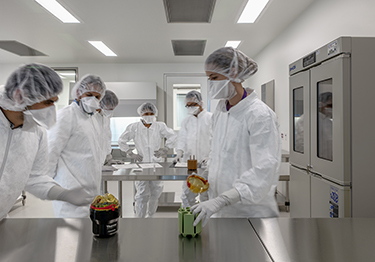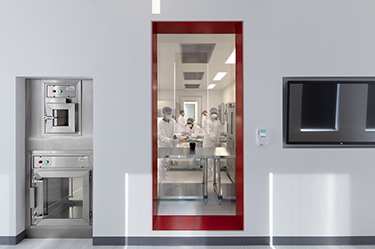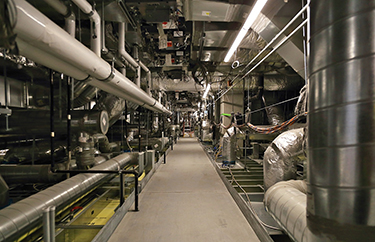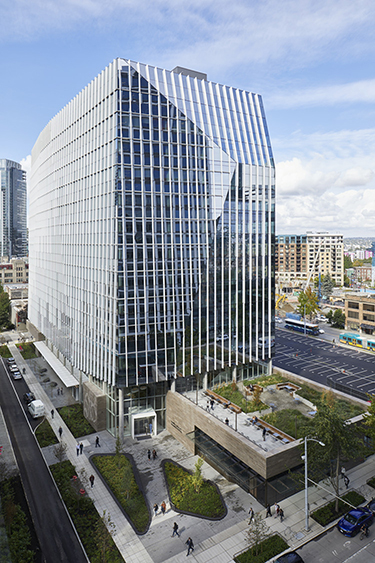|
Subscribe / Renew |
|
|
Contact Us |
|
| ► Subscribe to our Free Weekly Newsletter | |
| home | Welcome, sign in or click here to subscribe. | login |
Construction
| |
 |
February 27, 2020
A look inside the Cure Factory, Seattle Children’s new cell therapy lab
Lease Crutcher Lewis

Presser
|
When I used to think about health care facilities, what came to mind were sterile corridors fitted with crash rails, surgery suites filled with equipment and pharmacies lined with drugs. Today, I can’t help but acknowledge that a major disruptor to patient treatment is coming — and it brings new types of health care spaces with new challenges to owners, designers and construction professionals.
Cell therapy — reprogramming a patient’s living blood cells to fight disease — is showing incredible promise in treating several devastating diseases. Clinical trials have dramatically improved outcomes for patients with life-threatening conditions like leukemia and sickle cell anemia by using reprogrammed versions of each patient’s own blood cells.
The Cure Factory is Seattle’s newest cell therapy facility, recently opened by Seattle Children’s Research Institute at Building Cure. Building Cure is the Northwest’s first high-rise cell therapy building — a vertically-integrated system to cure childhood diseases, from development of new cures to programming the cells of patients.
Once a cell therapy application is proven, scientists at the Cure Factory on the 12th floor prepare cell therapy treatments for patients at Seattle Children’s and partner hospitals in the U.S. and Canada. These therapies modify a patient’s immune cells (T-cells) from blood samples to attack the harmful or diseased cells and teach the rest of the T-cells in a patient’s body to do the same.
The facility requirements for production of cell therapies are tightly controlled and vigorously monitored to meet the highest standards for drug production. The treated cells are fragile drugs that are regulated by the FDA, which requires certified Good Manufacturing Practice (cGMP) standards: clean-build protocols, validated monitoring systems, materials that can stand up to rigorous daily cleaning, and clear and independent maintenance access to equipment, lights and diffusers to ensure zero disruption to or contamination of the cell therapies.
Clean protocol
To guarantee cGMP integrity in the Cure Factory, we needed to ensure stringent clean-build protocols. This was an unusual challenge on a 600,000-square-foot high-rise project with over 700 skilled tradespeople cycling through during the various phases — far more than a typical cGMP jobsite in Seattle.
Two “levels” of clean-build protocol were adopted to protect the facility from potential contaminates during construction.
Level 1 protocol was a stringent baseline for the whole floor, including restricting access to those who had work on the floor and had received the training, a ban on food or drink other than water, keeping tools and equipment in good repair to prevent other material contamination and keeping ducts and pipes sealed from manufacture and transport to the point of installation.
The Level 2 protocol was an even higher standard within the cGMP space. Some aspects included limited access locations, sign in/out requirements, differential air pressures, “wipedown zones” for material and tools, limitations on dust-generating equipment, protective covers over footwear, and the careful tracking of material custody from manufacture to installation.
Successful education, implementation and compliance in restricted work areas was critical, and especially challenging given the large number of craft workers. A dedicated team carefully laid out the training program, created clear and easily understandable signage and space for logistics and material flow and tightly controlled the work sequencing.
They also partnered with Seattle Children’s to focus on worker understanding and buy-in, so each trade partner would be committed to the protocols. Seattle Children’s researchers and doctors periodically joined our safety meetings to bring the “why” message home to everyone — that what would take place inside these walls once we walked away would make a difference.
Systems and access
Building a vertically integrated research and production facility brings significant challenges to mechanical, electrical and plumbing systems and their installation sequences.
The Cure Factory requires dedicated mechanical and electrical services that can meet the operating requirements of an ultraclean space and redundancy requirements to ensure that the treatments will remain viable during a significant loss of power or natural gas service. Other research spaces in the building rely on vacuum systems, lab gases and controlled waste streams that must get to and from the laboratory across this same vertical stack of space.
To support this heavy infrastructure, the team created multiple mechanical floors the size of the entire building footprint, including one directly above the Cure Factory.
To thread the MEP infrastructure inside the Cure Factory, a double-height space was constructed with 20-foot floor-to-ceiling heights and walkable interstitial spaces installed under the concrete decks. The interstitial spaces allow Seattle Children’s building engineers to perform maintenance and servicing without disrupting the science below.
The interstitial space was organized with Seattle Children’s building engineers and maintenance team to ensure that each key system that needed maintaining was clearly organized and accessible within 5 feet of the catwalk.
It was important that we focused first on function and access and then finalized the remainder of the routing. By sorting out these details well in advance, we were able to prefabricate and install 20-foot-long multi-trade racks that included ductwork, piping, electrical panels and pathway for low voltage.
This planning allowed us to make sure every system fit perfectly and ensured future access to needed elements. Prefabrication allowed us to accelerate the complex installation.
Rallied by the mission
The success of the Cure Factory and Building Cure was due to a great team who rallied around the concept that our collective performance would enable Seattle Children’s to advance the science more quickly and be able to deliver potentially lifesaving patient treatments sooner.
This was embodied by our shared mantra: “Every dollar not spent constructing this building can be reallocated to curing childhood diseases. Every day not needed for construction means an extra day of research. A facility that performs precisely as designed means no disruption or delay to groundbreaking research.”
The design and construction team included Aedas, Flad, AEI, KPFF, McKinstry, Prime Electric and Andrew Clapham & Associates along with Lease Crutcher Lewis.
Here’s a greater success: The Cure Factory will allow Seattle Children’s to treat 10 times more patients than before, with up to 1,000 children a year receiving life-saving cell therapy every year.
As research advances and more clinical trials take place, cell therapy will only grow in prominence. Seattle Children’s alone is looking into applications for at least 80 more diseases!
With new advances and treatments will come new opportunities for design and construction professionals to make such facilities possible. We’re excited to see what’s next for patient care and how it could change the very makeup of health care facilities.
Coriann Presser is a project executive at Lease Crutcher Lewis.
Other Stories:
- Hospital projects in rural areas face extra obstacles
- UW’s new health sciences building will be a hub for 21st-century care
- Good design takes some stress out of visiting the hospital
- Building out this new hybrid OR was no simple operation
- Fire dampers: one more way hospitals can save lives
- Hospitals giving way to other care options as providers look to cut costs
- CHP systems: a powerful energy-saving tool for hospitals
- Health care could look a lot different in 2040, so get ready
- Here’s what’s in store for health care in the Northwest
- Integrated project delivery offers risks and rewards for team members
- How welcoming design can improve outcomes for patients — and staff







